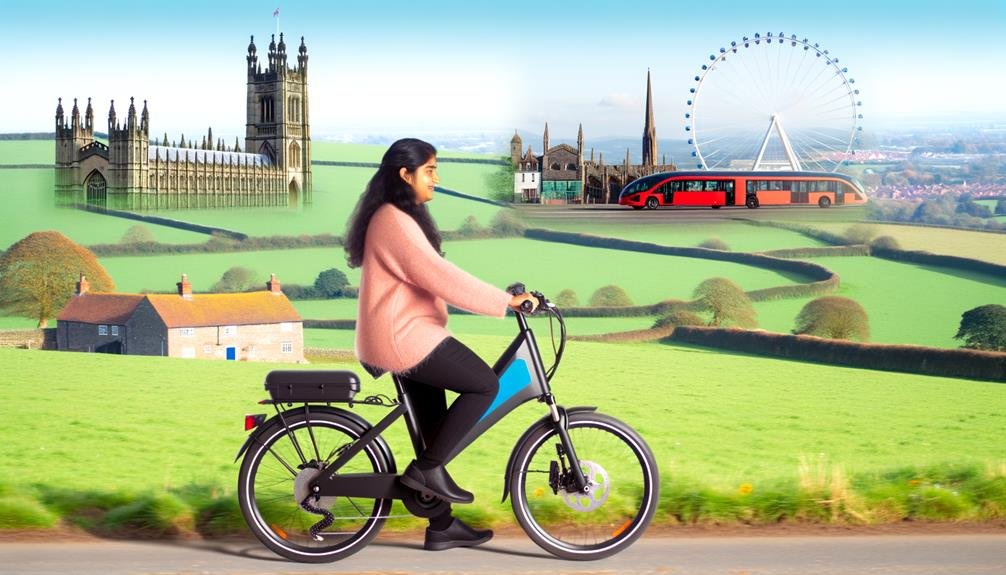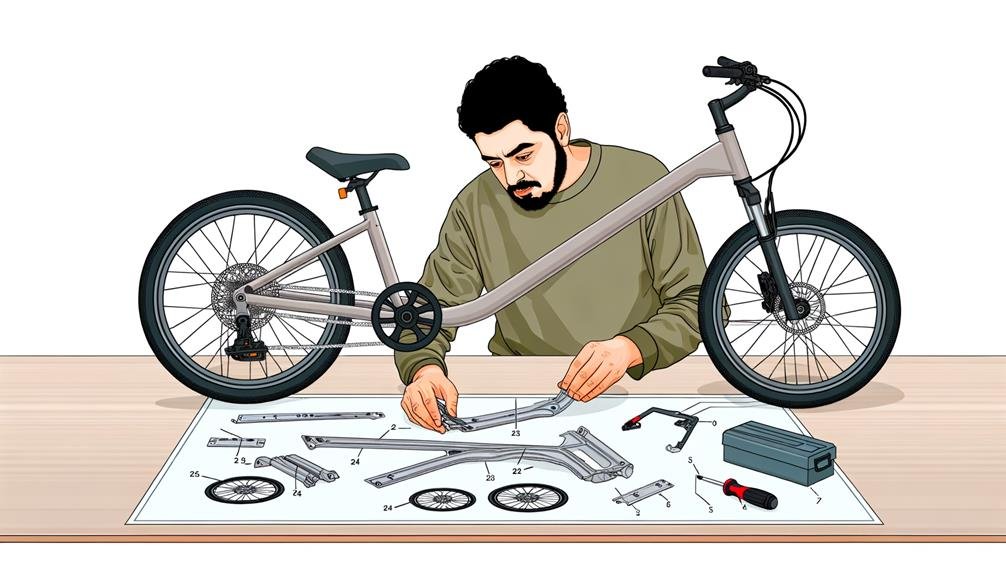Charles Miller is a veteran bike enthusiast with over 12 years of experience dealing with bikes as a mechanic. Despite immense love and expertise for...
We've all seen the rise in popularity of electric bikes, like when our neighbor started using one for his daily commute. It's clear that these bikes are not just a passing fad but a sustainable and efficient mode of transport that's gaining momentum fast.
However, with the market flooded with various models, styles, and features, how do we know which electric bike is the best for us? We'll cover everything you need to know – from understanding the types of electric bikes and their key features to considering your personal riding needs and budget.
With all these factors in mind, you might ask, 'What's next?' Well, you're about to find out.
- Key Takeaways
- Understanding Electric Bike Classes
- Exploring E-Bike Batteries and Motors
- Key E-Bike Features to Consider
- Ensuring a Good E-Bike Fit
- Types of Electric Bikes
- The Electric Bike Buying Process
- Considering Extra E-Bike Features
- Maintaining Your Electric Bike
- Frequently Asked Questions
- Conclusion
Key Takeaways
- Understanding the different classes of electric bikes (Class 1, Class 2, and Class 3) helps in choosing the right balance between speed, power, and cost, considering local regulations.
- Battery capacity, measured in watt hours (Wh), influences the riding range. Larger battery capacities offer longer distances but may require longer charging times.
- Motor power determines the e-bike's speed and torque. More powerful motors can drain the battery faster. Consider the location of the motor (mid-drive, rear, or front-hub drive) for different riding experiences.
- A good fit is crucial for a comfortable and efficient ride. Selecting the proper frame size, adjustable components, and considering weight distribution and riding position are important factors to ensure a good fit. Comfort and ergonomics, including saddle comfort and handlebar shape, enhance the riding experience.
Understanding Electric Bike Classes
To understand electric bikes thoroughly, it's crucial to grasp the three distinct classes they're divided into, each offering different levels of motor assistance.
The first electric bike class is Class 1. These bikes provide pedal-assist only, up to 20 mph. This means that they only give you a boost when you're pedaling, making them the most affordable and widely accepted class of e-bikes.
Next, we've Class 2 e-bikes. Like Class 1, they also offer pedal-assist up to 20 mph. However, they've an added feature: a throttle-powered mode. This gives you the ability to cruise without pedaling, adding a layer of convenience.
Lastly, we encounter the Class 3 electric bikes. These are for the speed enthusiasts. They provide pedal-assist up to a faster 28 mph. However, they lack a throttle mode and are solely pedal-assisted. They're more powerful but have limited access due to their speed.
Understanding electric bike classes is key to make an informed decision when you choose an electric bike. It's all about finding the right balance between speed, power, and cost that matches your specific needs and local regulations.
Exploring E-Bike Batteries and Motors
Diving into the heart of an e-bike, let's explore the batteries and motors, which significantly impact the bike's riding range, speed, and overall performance. E-bike batteries and motors are pivotal for a truly satisfying cycling experience.
The battery capacity, measured in watt hours (Wh), directly influences the riding range. Larger capacities offer longer distances, but keep in mind that charging times may increase accordingly. On the other hand, motor power is a vital aspect determining your e-bike's speed and torque. More powerful motors deliver higher speed yet can drain the battery faster.
A unique feature in some models is the ability to use multiple batteries, extending your riding range or serving as a backup. However, your riding range also depends on other factors like terrain, riding style, and assist level.
Here's a succinct table to better illustrate these points:
| Factor | Influence | Consideration |
|---|---|---|
| Battery Capacity | Riding Range | Charging Time |
| Motor Power | Speed and Torque | Battery Drain |
| Multiple Batteries | Extended Range | Extra Weight |
| Terrain and Riding Style | Riding Range | Energy Drain |
| Assist Level | Riding Range | Battery Usage |
Choose wisely to ensure you belong in the e-bike community!
Key E-Bike Features to Consider
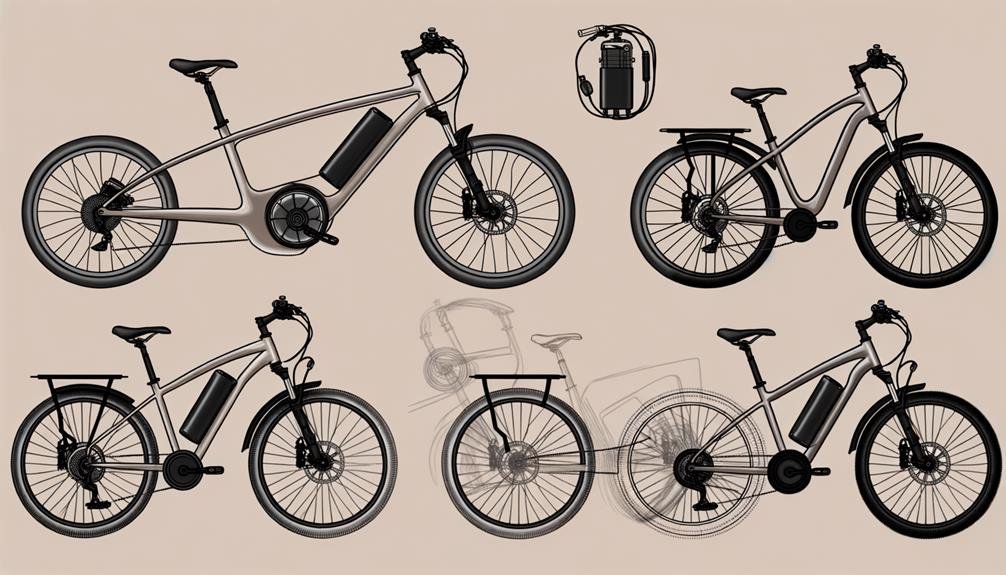
As we move on in our guide to choosing the best electric bike, it's important to consider key features that can greatly impact your riding experience.
From understanding the intricacies of e-bike power to comparing battery life, we'll provide you with the vital details.
In addition, we'll also highlight essential safety features that shouldn't be overlooked.
Understanding E-Bike Power
When choosing an electric bike, it's crucial to understand the power and key features that different models offer.
To start, let's focus on understanding e-bike power. Essential to all electric bikes are the motor and a battery. These components determine an e-bike's speed potential, riding range, and overall performance.
The motor's power, usually measured in watts, directly impacts the bike's acceleration and hill-climbing capabilities.
In terms of the battery, capacity is critical as it influences how far you can travel on a single charge. Remember, larger capacity means longer rides.
Also, consider the motor's location: mid-drive, rear, or front-hub drive, each offering unique riding experiences.
Understanding these aspects of power ensures you choose an e-bike tailored to your needs.
Essential Safety Features
Shifting our focus to safety features, it's vital to consider elements like integrated lighting, built-in security, and high-quality components when buying an electric bike. Integrated lighting ensures visibility during low-light conditions, while built-in security features like rear-wheel and battery locks deter theft. High-quality components, such as responsive brakes and reliable handling, optimize safety in various riding conditions.
Before buying, we suggest a test ride to experience these essential safety features firsthand. Specifically, assess the bike's stability and safety, particularly in urban areas with heavy traffic.
Here's a quick overview:
| Essential Safety Feature | Importance |
|---|---|
| Integrated Lighting | Enhances visibility in low-light conditions |
| Built-in Security | Discourages theft |
| High-Quality Components | Enhances safety and maneuverability |
Comparing Battery Life
In our quest to find the best electric bike, one of the key features we'll need to scrutinize is the battery life. When comparing battery life, consider the capacity, measured in watt hours (Wh), which gives us an indication of the riding range.
It's vital to understand that stronger motors can drain the battery faster, affecting the bike's overall performance. Battery charge time is another aspect to consider, typically ranging from three to five hours. The use of multiple batteries can extend range, enhancing the overall e-bike experience.
The type of motor, mid-drive or rear-wheel hub-drive, can also impact battery efficiency. Lastly, don't overlook integrated accessories and security features, like lighting, racks, and locks, for a safer ride.
Ensuring a Good E-Bike Fit
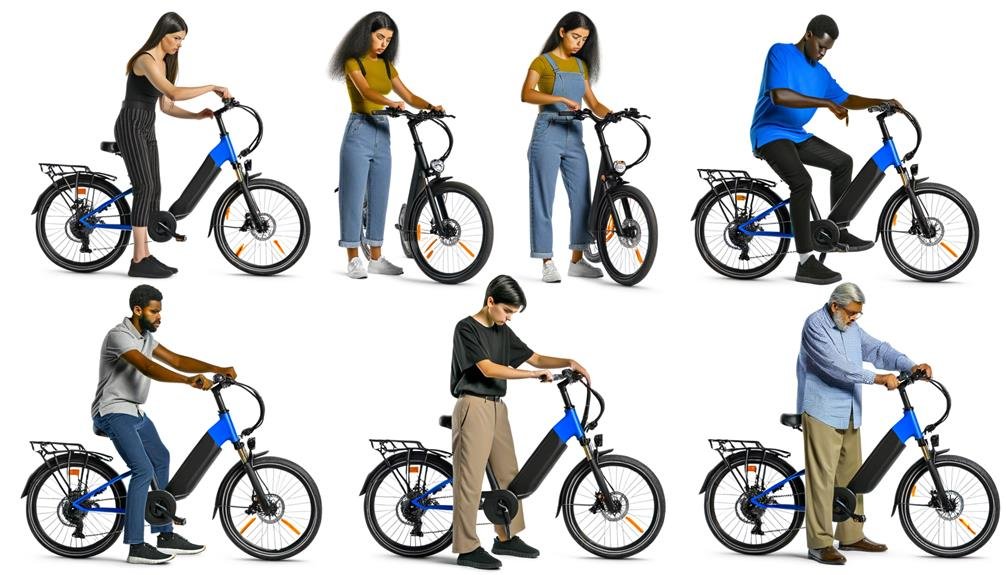
Ensuring a comfortable and efficient fit, we'll first examine the importance of selecting the proper frame size for your e-bike. A good electric bike should allow for a comfortable reach to the handlebars and appropriate leg extension while pedaling.
Remember, a Good Fit isn't just about comfort – it's key to ensuring your e-bike performs optimally and safely. To help you find the right e-bike, we advise you to:
- Take the e-bike for a test ride
- Gauge your comfort level
- Evaluate how well it suits your body posture
- Assess its compatibility with your riding style
- Look for adjustable components
- Handlebars
- Saddle height
- Stem length
- Consider the weight distribution and riding position
- An e-bike with balanced weight distribution will reduce strain
- A comfortable riding position will prevent discomfort on long rides
Lastly, don't overlook the importance of comfort and ergonomics. Pay close attention to factors like saddle comfort, handlebar shape, and overall design. Remember, the right e-bike will make you feel like you truly belong in the e-bike community.
Types of Electric Bikes
Let's delve into the various types of electric bikes available on the market – each designed with specific purposes and riders in mind. Understanding the different types of electric bikes will help you make sure you find one that fits your needs and riding style.
Firstly, we've Commuter Bikes. These are designed for practical transportation, making them versatile and comfortable for around-town errands and work commutes.
Cruisers are built for comfort, with plush seats, wider tires, and a relaxed upright seating position for leisurely rides.
Performance Road Bikes, lightweight and aerodynamic, are suitable for longer distances and steeper grades.
If you're into off-road riding, Mountain Bikes, with beefier frames and bigger tires, are built to handle rough terrain and obstacles.
Lastly, we've Cargo Bikes. These are designed for carrying heavy loads, making them useful for transporting goods or children.
Each type has unique features that cater to different types of riders, so it's essential to consider your specific needs and preferences before making a decision.
The Electric Bike Buying Process

Having explored the various types of electric bikes, we're now ready to guide you through the buying process, ensuring you choose the perfect e-bike that suits your riding needs and preferences.
Here's a simple step-by-step guide to help you make an informed decision:
- Understand Your Needs: Different e-bikes cater to different needs. Whether you're looking for a local bike for short commutes, or an e-bike for long-distance journeys, choosing the right one starts with understanding your specific needs.
- Urban commuting
- Off-road biking
- Long-distance travel
- Evaluate Electric Bike Features: Pay attention to the bike's motor, battery, and additional features.
- Motor: Check the motor's location and power.
- Battery: Consider the battery's lifespan and range.
- Additional features: Look for features like pedal assist levels, integrated accessories, and security features.
- Make a Comparison: Don't rush your decision. Compare different models and brands, considering their features and your budget to ensure you're making the best choice.
Considering Extra E-Bike Features
Diving into the realm of extra features, it's important to note that e-bikes offer a diverse range of accessories and security options, elevating both the convenience and protection of your biking experience. When considering extra e-bike features, we suggest you take a good look at the integrated accessories that e-bikes feature. These can include lighting, racks, handlebar-mounted displays, and even smartphone integration that can enhance your riding experience.
Also, let's not forget about security. Some e-bikes are equipped with built-in security features like rear-wheel locks and battery locks, providing an added layer of protection for your investment.
As we continue to explore how to choose the best electric bike, it's worth considering the pedal-assist activation and feel. These can vary among e-bikes, so don't hesitate to test ride to find the right fit for your needs. Most e-bikes offer multiple pedal-assist levels for different riding needs, allowing you to customize your riding experience to your liking.
Lastly, remember that the component quality varies based on price tiers, with higher-end e-bikes offering advanced features like smartphone integration. Choose wisely, and enjoy the ride!
Maintaining Your Electric Bike
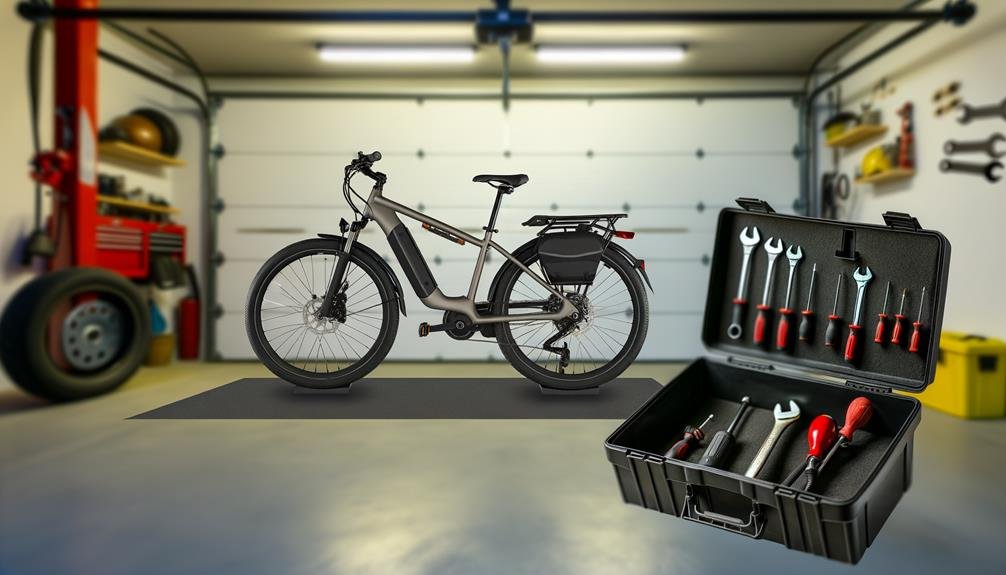
In the pursuit of optimal performance and longevity, it's crucial that we give proper attention to the maintenance of our electric bikes. Just as we'd with any other high-performance machine, maintaining your electric bike involves regular checks, proper cleaning, and timely repairs.
To break it down, here are some key steps to consider:
- Ensuring Optimal Performance
- Regularly check the motor, battery, and electrical connections. This guarantees not only performance but also safety.
- Keep your electric bicycle's battery charged. Follow the manufacturer's guidelines for storage and charging to prolong its lifespan.
- Prioritizing Safety
- Regularly inspect brakes, tires, drivetrain, and suspension. This guarantees safe and smooth operation.
- Preventing Wear and Tear
- Clean and lubricate the chain, gears, and other moving parts. This prevents wear and tear and maintains efficiency.
Lastly, don't hesitate to seek professional help from a bike shop for software/firmware updates and complex repairs. With proper care and attention, we can ensure the longevity and top-notch performance of our e-bikes.
After all, the joy of riding an electric bike lies not only in owning it but in maintaining it effectively too.
Frequently Asked Questions
What Should You Look for When Buying an Ebike?
When buying an e-bike, we'd look for long battery lifespan, sturdy frame durability, and comfort features. It's important we get the most out of our investment, ensuring it's a perfect fit for our lifestyle.
How Many Watts Should a Good Electric Bike Have?
We're exploring wattage importance in e-bikes. Typically, we'd recommend between 250W to 750W, depending on your needs. Higher wattage impacts power consumption and speed influence, so choose wisely for optimal performance.
Which Electric Bike Is Worth Buying?
We'd recommend an electric bike that balances durability, cost-effectiveness, and a reputable brand. It's crucial to compare prices, consider the bike's longevity, and research brands for their reliability before making a purchase.
What Is the Difference Between an E-Bike and an Electric Bike?
We're comparing e-bike advancements and electric bike regulations. While they're similar, differences lie in speed, pedal-assistance, and legal regulations. It's important we understand these variations to truly appreciate the diverse biking world.
Conclusion
As we conclude our guide to choosing the best e-bike, let's envision a smooth ride on the bike of our dreams.
It's perfectly tailored to our needs, with the right classes, battery, and motor. We've considered all the key features, ensuring a perfect fit.
We've explored various types, navigated the buying process and even thought about extra features and maintenance.
Armed with this knowledge, we're ready to embark on our e-bike journey.
Happy e-biking!

Charles Miller is a veteran bike enthusiast with over 12 years of experience dealing with bikes as a mechanic. Despite immense love and expertise for his Tacoma, he rides his Trek Ebike more. Anytime you meet him, you’ll either hear him talking about Bikes, or writing about all things bikes and cars on this blog.
More Posts
